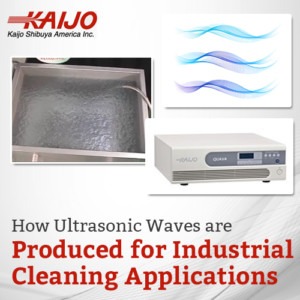How Ultrasonic Waves Are Produced for Industrial Cleaning Applications
March 16, 2018
Industrial ultrasonic cleaners deliver more effective and efficient cleaning performance without the use of harsh chemicals typically used in traditional cleaning methods. A variety of parts, from robust metal and ceramic components to delicate semiconductors can be cleaned quickly and completely via the cavitation bubbles from ultrasonic waves generated from an ultrasonic system. Parts of all shapes are immersed in cleaning tanks with the bubbles cleaning even hard-to-access holes and crevices. The systems are available in varying frequencies to satisfy the requirements of any industrial cleaning application.
deliver more effective and efficient cleaning performance without the use of harsh chemicals typically used in traditional cleaning methods. A variety of parts, from robust metal and ceramic components to delicate semiconductors can be cleaned quickly and completely via the cavitation bubbles from ultrasonic waves generated from an ultrasonic system. Parts of all shapes are immersed in cleaning tanks with the bubbles cleaning even hard-to-access holes and crevices. The systems are available in varying frequencies to satisfy the requirements of any industrial cleaning application.
Ultrasonic Cleaning System Components
Industrial ultrasonic cleaning systems are made up of ultrasonic generators, transducers and the cleaning tank. They can be purchased as separate units or as turnkey systems that can be plugged in and are ready to start cleaning. When existing cleaning tanks can be used, it is often cost-effective to buy generators and portable immersible transducers while tabletop turnkey solutions are ideal for cleaning small parts. Choosing a supplier that has a full range of industrial ultrasonic cleaners will help in getting the system that best suits a particular application.
The ultrasonic generator produces the electric signal that forms the basis for the ultrasonic waves. Signals can range from about 20 kHz to 200 kHz (for ultrasonic frequencies) and 200 Khz to 1.6 MHz (for megasonic frequencies), and the generators can deliver up to 1200 W of power. For specific applications, a single frequency generator is sufficient, but for cleaning applications that handle many different kinds of parts, multi-frequency generators are available.
The electric ultrasonic signal generates ultrasonic waves via an ultrasonic cleaning transducer. The transducer has to be able to handle the frequency and power produced by the generator and it can be mounted at the bottom or on the sides of the tank as well as being an independent unit placed in the tank. Large tanks may need more than one transducer to effectively fill the volume of the tank with ultrasonic waves.
The cleaning tank has to be made of material heavy enough to withstand the cleaning action of the ultrasonic waves and it has to be big enough to handle the largest parts to be cleaned. Baskets for the parts are often used to keep easily damaged components from vibrating against the sides or bottom of the tank, and in that case, the tank has to be big enough to hold the basket as well.
How Ultrasonic Cleaners Work
The ultrasonic transducer takes the electric signal from the generator and uses either piezoelectric or magnetic effects to create ultrasonic waves in the cleaning solution. When an electric charge is applied to piezoelectric crystals, they change size. As a result, a high-frequency electric signal produces a vibration in the crystals and, via a heavy metal plate, the crystals can produce ultrasonic waves in the cleaning liquid. The same effect can be achieved with materials that change size in magnetic fields. The ultrasonic waves fill the cleaning tank and start the cleaning action.
When an ultrasonic wave travels through water, it creates compression peaks and troughs. Microscopic bubbles form in the troughs where the pressure is low and collapse in the peaks due to the high pressure. When a bubble collapses, a small but powerful jet of liquid rushes into the space where the collapsed bubble was. These jets produce an intense cleaning action on the surfaces of the parts to be cleaned. Cleaning takes place wherever the bubbles are present, throughout the tank, inside cavities and all around complex structures. Cleaning is fast and removes all contaminants.
Kaijo can Help
Kaijo has a complete line of industrial ultrasonic cleaning equipment, including separate components and turnkey systems. The company uses transducers based on the piezoelectric effect and can deliver powerful low-frequency systems for robust cleaning action as well as systems using high frequencies for gentle cleaning of delicate components. Kaijo’s unparalleled experience in developing ultrasonic technology for various industrial cleaning applications ensures that the company’s equipment delivers the expected performance.





